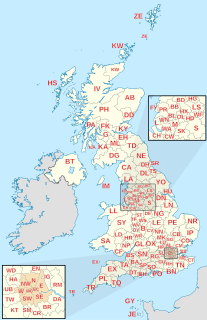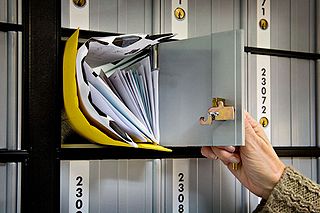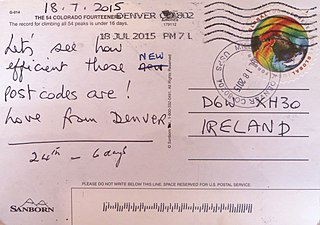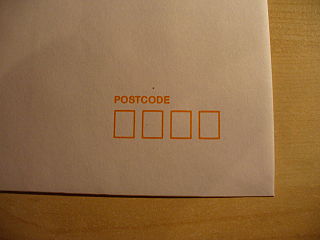Related Research Articles

A postal code is a series of letters or digits or both, sometimes including spaces or punctuation, included in a postal address for the purpose of sorting mail.

A ZIP Code is a postal code used by the United States Postal Service (USPS). Introduced on July 1, 1963, the basic format consisted of five digits. In 1983, an extended ZIP+4 code was introduced; it included the five digits of the ZIP Code, followed by a hyphen and four digits that designated a more specific location.

Postal codes used in the United Kingdom, British Overseas Territories and Crown Dependencies are known as postcodes. They are alphanumeric and were adopted nationally between 11 October 1959 and 1974, having been devised by the General Post Office. A full postcode is known as a "postcode unit" and designates an area with several addresses or a single major delivery point.

A Canadian postal code is a six-character string that forms part of a postal address in Canada. Like British, Irish and Dutch postcodes, Canada's postal codes are alphanumeric. They are in the format A1A 1A1, where A is a letter and 1 is a digit, with a space separating the third and fourth characters. As of October 2019, there were 876,445 postal codes using Forward Sortation Areas from A0A in Newfoundland to Y1A in the Yukon.
POSTNET is a barcode symbology used by the United States Postal Service to assist in directing mail. The ZIP Code or ZIP+4 code is encoded in half- and full-height bars. Most often, the delivery point is added, usually being the last two digits of the address or PO box number.
Postcodes in New Zealand consist of four digits, the first two of which specify the area, the third the type of delivery, and the last the specific lobby, RD number, or suburb. The present postcode system was introduced in New Zealand in June 2006, which, unlike the previous system, applies to all items of mail with effect from June 2008. In October 2008, New Zealand Post launched a 'remember your postcode' campaign, offering a NZ$10,000 prize for remembering a postcode.
Postal codes were introduced in France in 1964, when La Poste introduced automated sorting. They were updated to use the current 5 digit system in 1972.

A post office box is a uniquely addressable lockable box located on the premises of a post office.
An address is a collection of information, presented in a mostly fixed format, used to give the location of a building, apartment, or other structure or a plot of land, generally using political boundaries and street names as references, along with other identifiers such as house or apartment numbers and organization name. Some addresses also contain special codes, such as a postal code, to make identification easier and aid in the routing of mail.

A "postal address" in Ireland is a place of delivery defined by Irish Standard (IS) EN 14142-1:2011 and serviced by the universal service provider, An Post. Its addressing guides comply with the guidelines of the Universal Postal Union (UPU), the United Nations-affiliated body responsible for promoting standards in the postal industry, across the world.
A private mail bag (PMB), locked bag or caller service is a term for a special form of postal delivery in some countries, usually a government department or large private company, which receive large volumes of mail. Private mail bag addresses are often used in countries in Africa where there may be no street delivery service.

Postcodes in Australia are used to more efficiently sort and route mail within the Australian postal system. Postcodes in Australia have four digits and are placed at the end of the Australian address, before the country. Postcodes were introduced in Australia in 1967 by the Postmaster-General's Department and are now managed by Australia Post, Australia's national postal service. Postcodes are published in booklets available from post offices or online from the Australia Post website.

Código de Endereçamento Postal is the Brazilian postal code system commonly known as CEP. Introduced in 1972 as a sequence of five digits, it was expanded to eight digits in 1992 to allow for more precise localization. The standard format is "nnnnn-nnn".
In 2004 a new postal code system was introduced in Iraq.

In Poland, postal codes were introduced in 1973. They are five-digit codes of two-then-three digits, with a hyphen between them. The first digit indicates one of the 10 large postal regions the country is divided into. These areas do not follow the administrative divisions. The second and third digits specify a particular smaller region, and the last two are the number of a postal delivery branch.

Namibia, formerly known as South West Africa and German South West Africa, has a long history of postal services, starting in 1814 with postal runners delivering messages among mission stations. The first stamps were printed during the German colonial period. Currently NamPost is responsible for running postal services, managing 135 postal offices in the country.

A mail pouch or mailpouch is a container for mail, designed to transport first-class, registered mail, domestic mail and military mail. It usually has a drawstring, and is made of a stronger material than mail sacks and is designed to lock at the top with a mechanism system consisting of special closely spaced eyelets and a strong strap to secure the top where access into the bag is closed off and locked, where a mail sack does not have these features.

A mail bag or mailbag is a generic term for a type of bag used for collecting, carrying, categorizing, and classifying different types of postal material, depending on its priority, destination, and method of transport. It is oftentimes used by a post office system in transporting these different grades of mail. The mailbag is carried by some means of transporting like a mail carrier, animal, or a mobile post office. Letters and printed material delivered by mail in the seventeen-hundreds were carried by horse in a saddle bag. There are several different types of mailbags for different purposes. These different styles of mailbags depend on its size and purpose. It can range from "a large bag used for transporting mail on a truck, plane, etc." to a simple "postbag" used by a mail carrier to deliver mail.
After 28 years without a postal code system in Namibia, the national postal service provider NamPost introduced new postal codes in December 2018.
References
- ↑ South Africa 1978: Official Yearbook of the Republic of South Africa, Department of Information, 1978, page 445237 Redchurch Street Namibia
- ↑ South Africa, Universal Postal Union,
- ↑ "Kempston Car Rental - Port Elizabeth". Archived from the original on 23 February 2016. Retrieved 15 February 2016.
- ↑ "South African Reserve Bank". Archived from the original on 21 April 2017. Retrieved 7 October 2016.
- ↑ Yeoville - St Francis of Assisi Catholic Church Est. 1912
- ↑ South African Panorama - Volume 22, South African Information Service, 1977, page 9
- ↑ The comprehensive handbook of the postmarks of German South West Africa, South West Africa, Namibia, Ralph F. Putzel, R.F. Putzel, 1991, page 173